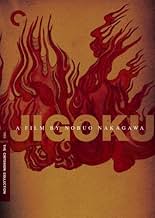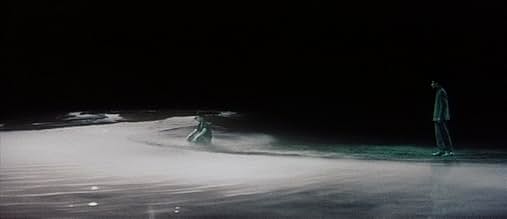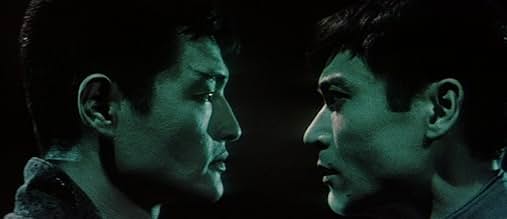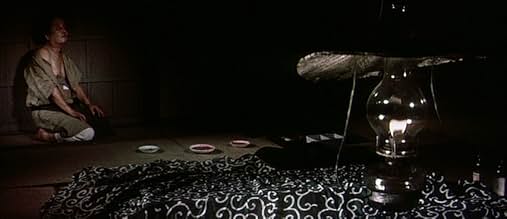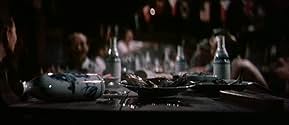IMDb RATING
6.7/10
4.8K
YOUR RATING
A group of sinners involved in interconnected tales of murder, revenge, deceit and adultery all meet at the Gates of Hell.A group of sinners involved in interconnected tales of murder, revenge, deceit and adultery all meet at the Gates of Hell.A group of sinners involved in interconnected tales of murder, revenge, deceit and adultery all meet at the Gates of Hell.
- Director
- Writers
- Stars
Akira Nakamura
- Professor Yajima
- (as Torahiko Nakamura)
- Director
- Writers
- All cast & crew
- Production, box office & more at IMDbPro
Featured reviews
Words can't aptly describe the assault on the senses that is JIGOKU but I'll try anyway: over-used phrases like fascinating, surreal, disturbing and unique instantly come to mind - but the film is all of these and more. By now, I have a fair number of strange Japanese films under my belt - but this one's something else entirely!
From the stylized approach (shooting from odd angles and the occasional adoption of a greenish hue) to its plethora of arresting imagery (especially the gruesome body piercing - sword through neck, eye-gouging, feet stamping on huge needles, torso sawed in half, etc.), director/co-writer Nakagawa's vision of Hell is surely among the most visceral ever depicted on the screen. While its concept of establishing sections (or circles) of punishment for specific crimes goes all the way back to Dante Alighieri - though, as mentioned in the film itself, Buddhism has its own take on the subject - cinematically it anticipates the one seen in the Coffin Joe outing THIS NIGHT I'LL POSSESS YOUR CORPSE (1966). Still, with respect to both the microcosmic viewpoint of the plot and the film's vivid color scheme, it also reminded me of GOKE - BODY SNATCHER FROM HELL (1968), while its essential nihilism (I literally lost count of the number of people killed off during the first hour!) looks forward to BLIND BEAST (1969).
The doppelganger element - in the DVD's main supplement, a 39-minute featurette, it's mentioned that the script was partly inspired by the Faust legend - heightens the film's already disquieting aura: Yoichi Numata as an emissary of Hell in human form (though he's not spared the painful retribution for his sins once the scene shifts to the netherworld) is especially effective; interestingly, the actor was disappointed by his own performance and admits now that he couldn't understand the role! However, I need to point out that - much like I had written of Ingmar Bergman's THE RITE (1969) - the plot reaches a level of implausible melodrama as to feel almost like a parody (even more so when considering the various characters' penchant for bursting into sentimental songs a' la the work of John Ford!).
Anyway, while I found the DVD transfer somewhat dark, I'm glad to say that the copy I own is the 'Second Pressing' - this means that the problem concerning a 2-minute sequence, which previously got skipped when watching the disc on a DVD player, has now been fixed. Originally intended for Eclipse, Criterion's sub-label - back when it was supposed to release little-known genre/exploitation titles - I feel that the film is important enough to warrant its place in the official Collection.
The bits from GHOST STORY OF YOTSUYA (1959) shown in the featurette were very intriguing and, hopefully, won't be too long in coming; still, I was equally itching to learn more about the various 'B' horror films by Nakagawa and production company Shintoho (which had actually started out by making such masterworks of World Cinema as Akira Kurosawa's STRAY DOG [1949] and Kenji Mizoguchi's THE LIFE OF OHARU [1952]!) whose posters form the extensive still gallery...
Although I have to admit that I'd never heard of the film prior to Criterion's DVD announcement, Chuck Stephens - in his rather pretentious essay in the accompanying booklet (though he perceptively suggests that the pairing of the dead yakuza's mother and girlfriend may well have anticipated the deadly female relatives of ONIBABA [1964]) - believes that JIGOKU ought to be thought of in the same terms as such horror landmarks as EYES WITHOUT A FACE (1959), BLACK Sunday (1960), PEEPING TOM (1960) and PSYCHO (1960), films which collectively brought an unprecedented maturity to the genre. Needless to say, the film's greatest influence can be seen in the gore-drenched Asian exploitation cinema which survives to this day (interestingly enough, JIGOKU was itself remade twice over the years - in 1979 and 1999!).
From the stylized approach (shooting from odd angles and the occasional adoption of a greenish hue) to its plethora of arresting imagery (especially the gruesome body piercing - sword through neck, eye-gouging, feet stamping on huge needles, torso sawed in half, etc.), director/co-writer Nakagawa's vision of Hell is surely among the most visceral ever depicted on the screen. While its concept of establishing sections (or circles) of punishment for specific crimes goes all the way back to Dante Alighieri - though, as mentioned in the film itself, Buddhism has its own take on the subject - cinematically it anticipates the one seen in the Coffin Joe outing THIS NIGHT I'LL POSSESS YOUR CORPSE (1966). Still, with respect to both the microcosmic viewpoint of the plot and the film's vivid color scheme, it also reminded me of GOKE - BODY SNATCHER FROM HELL (1968), while its essential nihilism (I literally lost count of the number of people killed off during the first hour!) looks forward to BLIND BEAST (1969).
The doppelganger element - in the DVD's main supplement, a 39-minute featurette, it's mentioned that the script was partly inspired by the Faust legend - heightens the film's already disquieting aura: Yoichi Numata as an emissary of Hell in human form (though he's not spared the painful retribution for his sins once the scene shifts to the netherworld) is especially effective; interestingly, the actor was disappointed by his own performance and admits now that he couldn't understand the role! However, I need to point out that - much like I had written of Ingmar Bergman's THE RITE (1969) - the plot reaches a level of implausible melodrama as to feel almost like a parody (even more so when considering the various characters' penchant for bursting into sentimental songs a' la the work of John Ford!).
Anyway, while I found the DVD transfer somewhat dark, I'm glad to say that the copy I own is the 'Second Pressing' - this means that the problem concerning a 2-minute sequence, which previously got skipped when watching the disc on a DVD player, has now been fixed. Originally intended for Eclipse, Criterion's sub-label - back when it was supposed to release little-known genre/exploitation titles - I feel that the film is important enough to warrant its place in the official Collection.
The bits from GHOST STORY OF YOTSUYA (1959) shown in the featurette were very intriguing and, hopefully, won't be too long in coming; still, I was equally itching to learn more about the various 'B' horror films by Nakagawa and production company Shintoho (which had actually started out by making such masterworks of World Cinema as Akira Kurosawa's STRAY DOG [1949] and Kenji Mizoguchi's THE LIFE OF OHARU [1952]!) whose posters form the extensive still gallery...
Although I have to admit that I'd never heard of the film prior to Criterion's DVD announcement, Chuck Stephens - in his rather pretentious essay in the accompanying booklet (though he perceptively suggests that the pairing of the dead yakuza's mother and girlfriend may well have anticipated the deadly female relatives of ONIBABA [1964]) - believes that JIGOKU ought to be thought of in the same terms as such horror landmarks as EYES WITHOUT A FACE (1959), BLACK Sunday (1960), PEEPING TOM (1960) and PSYCHO (1960), films which collectively brought an unprecedented maturity to the genre. Needless to say, the film's greatest influence can be seen in the gore-drenched Asian exploitation cinema which survives to this day (interestingly enough, JIGOKU was itself remade twice over the years - in 1979 and 1999!).
I guess this doesn't really belong with my more extreme reviews but for all it's stunningly beautiful scenes, it's heavily symbolic imagery and symbolism this still, even over 40 years, has a punch or two to unleash. It is for the most part a tragic tale that involves an almost laughable number of deaths and other misfortunes but hell always beckons. The last half hour or so is a considerably finely worked series of hellish landscapes with not a little graphic violence that could certainly not have been shown in the UK in 1960. Along the way there are many delights and a cool jazzy score. Fascinating, groundbreaking and most enjoyable.
I read about this movie when I was a kid. Never thought that much about it since I would probably never see it. Recently rented it off Netflix and WOW! Nakagawa's message comes through loud and clear across 46 years and the even wider cultural gap between US and Japan. Unusual stylization (truly hope to see this on a theater screen someday) is incredibly effective as a purely aesthetic experience (meaning you could turn off the subtitles and still be enthralled by the visuals and the music) AND as an elegy for the Japanese traditions of beauty and honor. You can read the various summaries in other posts. Suffice it to say this movie qualifies as a masterpiece if you don't go into it with "horror movie" expectations. See it!
The kind of film that sounds really exciting, and is interesting, but you wish it were a bit better than it is. Its reputation is based mostly on the final 40 minutes, where all the characters take a vacation to the bowels of Buddhist Hell (pretty much like Christian Hell, but with more lotus flowers). The first hour or so isn't much less hellish. A college student and his wicked friend mow down a drunk gangster in their car. The student, burdened with guilt (somewhat nonsensical guilt seeing as it wasn't his fault), starts seeing tragedy occur all around him. In just the next several days, all kinds of people with whom he associates die. It's never his fault, per se, but for some reason he always blames himself. That first hour is a little boring and a little confusing I was wondering if the guy was supposed to already be in hell. The hell part is pretty cool, but also fairly silly. What always works in Jigoku is the cinematography and art direction. This is a damn cool looking movie. I wouldn't particularly recommend it, but it's worth seeing just for the cool parts.
I usually find it positive if I can't categorize a movie and Jigoku surely gets the point from that. It's somewhat bizarre combination of drama, horror, film noir and art house where happy moments are more rare than good movies in Hollywood.
While the hell sequences of Jigoku seem to gather most of the attention I think that the story as a whole is what makes this movie good. It proceeds fluently from disaster to another and while some events lead to unexpected results the script never leaves a viewer with a feeling that the twist was added just for the twist's sake (as is the case with many new movies).
Technically the movie is awesome; good acting, great score (especially the haunting vocals) and beautiful cinematography. From modern perspective some of the hell sequences are way outdated (mainly the demons) while some look brilliant even today (settings like the river bank and some of the gore effects like the guy who gets flayed).
I doubt that Jigoku pleases everyone but if you're into bleak and uncompromising movies this is almost a must see. 8/10
While the hell sequences of Jigoku seem to gather most of the attention I think that the story as a whole is what makes this movie good. It proceeds fluently from disaster to another and while some events lead to unexpected results the script never leaves a viewer with a feeling that the twist was added just for the twist's sake (as is the case with many new movies).
Technically the movie is awesome; good acting, great score (especially the haunting vocals) and beautiful cinematography. From modern perspective some of the hell sequences are way outdated (mainly the demons) while some look brilliant even today (settings like the river bank and some of the gore effects like the guy who gets flayed).
I doubt that Jigoku pleases everyone but if you're into bleak and uncompromising movies this is almost a must see. 8/10
Did you know
- TriviaThe film's production company was going out of business while the film was being completed, leading to budget-saving tactics such as the actors helping dig their own holes in the movie's set for Hell. Critics kidded that this film killed the Shintoho Studio.
- GoofsWhile Shiro is on the rope bridge, we see him at various times hanging on to the side handrails. Between shots, without him having changed position, these handrails quite noticeably change in diameter from thin cables to a much thicker cable, indicating that some shots were filmed on a real bridge, others were filmed on a studio mock-up.
- Quotes
Tamura: So you want to turn me in for manslaughter?
Shiro Shimizu: We're the ones who killed him. We caused it. Let's go together. Please.
Tamura: That might ease your conscience, but I'm not interested. It'd be stupid. He was drunk. He ran into the road. It was basically suicide. Besides, he was just some yakuza scum. He's not worth the best years of our lives.
- ConnectionsFeatured in Building the Inferno: Nobuo Nakagawa and the Making of 'Jigoku' (2006)
- SoundtracksComin' through the Rye
(uncredited)
Music: traditional
Japanese lyrics: unknown
- How long is The Sinners of Hell?Powered by Alexa
Details
- Runtime1 hour 41 minutes
- Aspect ratio
- 2.35 : 1
Contribute to this page
Suggest an edit or add missing content


